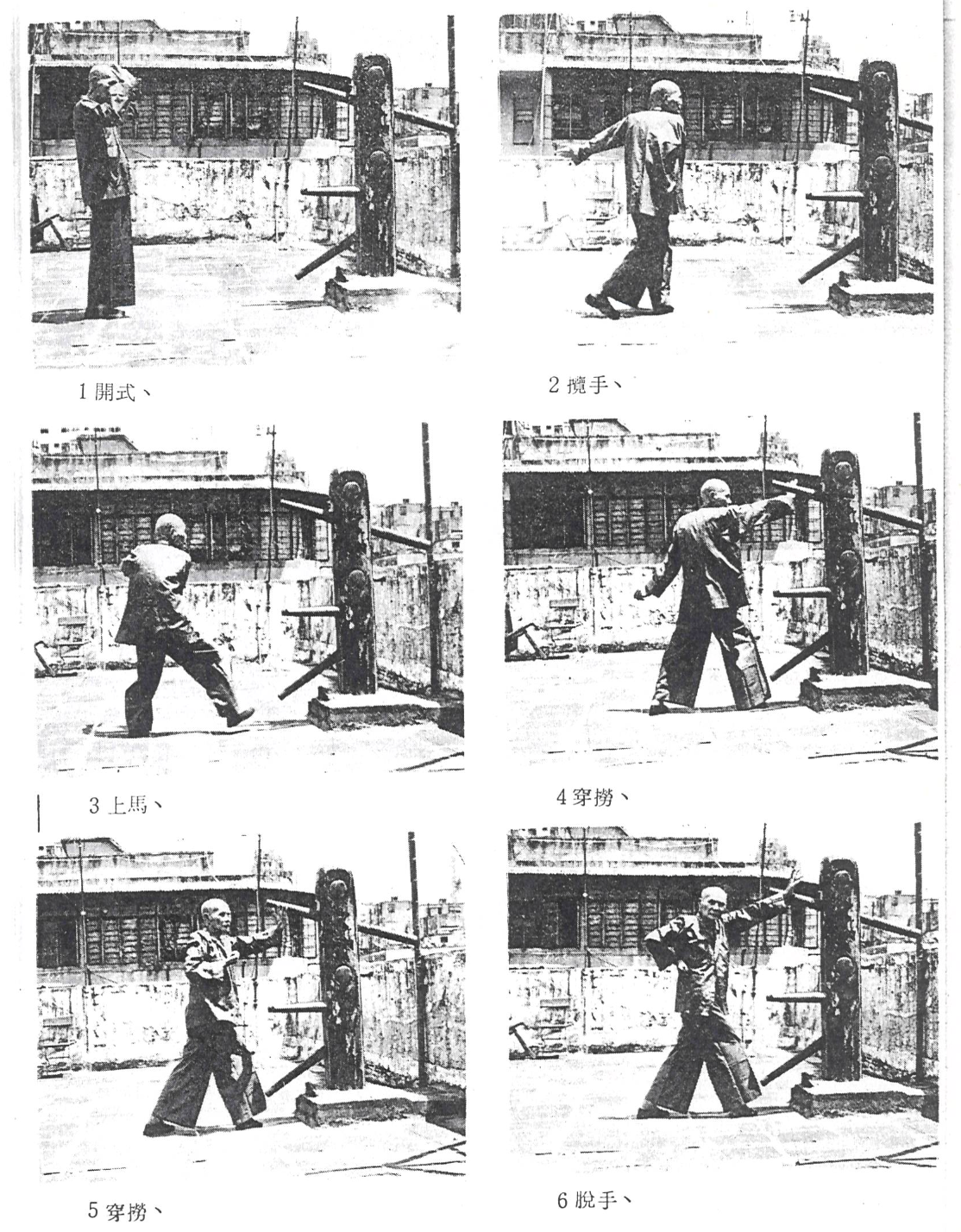Choy Lee Fut Wooden Dummy Techniques - Performed by So Gam Fok
Hung Sing Choy Lee Fut 鴻勝蔡李佛⽊⼈椿法 (Wooden Dummy Techniques) integrates various hand techniques for comprehensive training. In different environments, the use of various hand methods aims to train bridge-arm strength, agile footwork, quick hands, sharp eyesight, and spirit. The hand techniques combine many forms from Choy Lee Fut, including sap jing kyun (⼗ 形 拳), ng jing zang (五 形 拳), fut kyun (佛 拳), kao daa suk (靠 打 拳), mui faa zoeng (梅 花 掌), lo hon lei (羅 漢 拳), hok jing fung (Crane Form - 鶴 形 拳), fu jing kyun (虎 形 拳), hau jing kyun (Monkey Form - 猴 形 拳), etc. This set emphasizes the characteristics of the Ten Forms, though other forms are also incorporated as supplementary. Through the blending and interaction of different forms, various hand techniques from different angles are produced. Among these, practicing with the wooden dummy is most suitable. The Hung Sing Choy Lee Fut wooden dummy is also unique in its setup, distinguishing between ‘saang sau’ (life hand) and ‘sei sau’ (death hand). The dummy body is surrounded by appropriately placed sandbags, each representing vulnerable parts of the human body. The wooden dummy is about one foot taller than an average person. The upper part has sandbags on the center, right, and left, representing the forehead, eyes, and temples. In practice, techniques like coeng ngaan ceoi (搶眼搥), ji long zang zyu (二龍爭珠), zing zoeng gin zi (正掌劍指), fu zaau (虎爪) are used to attack the central sandbag. For the side sandbags, techniques like hok ding sau (鶴頂手), gwaa ceoi (掛搥), gwai wong bo sin (鬼王撥扇, soft palm) are used. The left upper sandbag is attacked with hok zeoi zoek (鶴咀啄), left gwai wong bo sin (鬼王撥扇, soft palm), biu zong (標撞), etc. About seven inches below, there is a highly elastic dummy arm, called cing coeng sau (秤椿手) or ‘living dummy arm’ in Hung Sing Choy Lee Fut. It moves up and down with great flexibility, representing the full range of frontal attacks. In practice, it is used for cyun laau (穿撈), pun kiu (盤橋), siu ceoi (掃搥), cin zi ceoi (千字搥), caap ceoi (扱搥), biu zong (標撞), min sau (面手), kam naa (擒拿), etc. About one and a half feet below, there are sandbags on the front, left, and right. The central sandbag is for practicing zing fai ceoi (正揮搥), nau fai ceoi (扭揮搥, jam fai, joeng caap), ding goek (釘腳), and caang goek (撐腳), representing the solar plexus. When practicing swinging strikes, there are techniques like seoi maa siu (說馬掃), lok maa fai (落馬揮), soeng maa fai (上馬揮), biu maa fai (標馬揮), zing san sei ping siu (正身四平掃), diu maa caap (吊馬插), zi ng caap (子午插), etc. The left and right sandbags represent the ribs, and are used for bin ceoi (鞭搥), taat ceoi (撻搥), zou maa pin san ping fai ceoi (走馬偏身平揮搥), and in footwork, kyuun maa caang zoeng (圈馬撐掌), gwaai maa bin ceoi (拐馬鞭搥), gwaai maa taat ceoi (拐馬撻搥), diu maa ding zoeng (吊馬頂掌), sei ping taat ceoi (四平撻搥), zyun san bin ceoi (轉身鞭搥), etc.

The lower dummy arms are installed in the middle of the dummy body, about two feet from the ground. In practice, they are mainly used for gun sau (滾手), caap faa sau (插花手), kiu (橋), pik ceoi (劈搥), saam sing sau (三星手), soeng gun kiu sau (雙滾橋手), ham sau (冚手), soeng fung sau (雙封手), etc. Footwork includes zou maa (走馬), left and right zyun maa (轉馬), zi ng maa (子午馬), etc. The lowest part is the dummy leg, set at a slight downward angle, representing the lower stance of a dummy. In practice, techniques include zing san cam goek (正身琛腳), caan goek (鏟腳), pin san cit goek (偏身切腳), taap goek (踏腳), daan goek (彈腳), etc. In terms of stances, there are zou maa (走馬), gwaai maa (拐馬), zyun san gwai maa (轉身跪馬), etc. For hand techniques, the entire wooden dummy practice emphasizes soeng bou paai zoeng (雙抱排掌), gong lung zoeng (降龍掌), etc., moving around the dummy body, attacking from different angles with both palms. Such comprehensive practice aims to integrate body movement, stances, and hand techniques into one.
